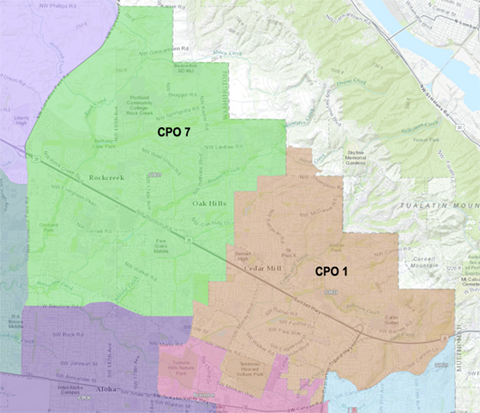County proposes changes to CPO program

By Bruce Bartlett, CPO 1 Vice Chair and Chair of CCI
In November, we introduced readers to the Community Participation Organization (CPO) Modernization program, a long-anticipated effort by Washington County administration to change many aspects of the CPO system. This month, we are sharing thoughts on one of the elements of the proposal: changes to the Focus and Scope of the future CPO program. Changes are also proposed for descriptive language, membership and how leaders are selected, geographic boundaries, and program requirements. Community members are encouraged to provide input about the recommendations by taking this online survey.
The ”Updated Focus and Scope” element is described as: Restoring the original focus of the CPO/CCI program so that it advises the Board of County Commissioners primarily about land use and transportation planning within Washington County’s unincorporated areas. The CPOs and CCI would continue to provide opportunities for community updates on other topics.

Missing from this guideline is the original CPO program focus of providing civic education—how our county works—to all county residents. Designed by the OSU Extension Service, education was inherently a part of the CPO program. Now, civic education is provided only to a subset of residents as the county’s Civic Leaders Program has highly constrained enrollment requirements.
There are two messages in this guideline: CPOs are primarily (solely?) to focus on the county’s Land Use and Transportation (LUT) planning topics, and they are allowed to provide “community updates.” For the 50-year duration of the CPO program, LUT planning topics have not drawn wide-spread interaction from the community unless that planning was directly impacting a particular neighborhood. The Cedar Mill Town Center planning process of the early 2000’s was well engaged because of the immediacy of the impact. Also, the county’s Urban/Rural Reserves effort of the early 2010’s was actively engaged by people directly affected but certainly not by the overall community. The LUT Planning Work Program, the LUT Transportation System Plan, state law mandated Middle Housing, and even the Significant Natural Resource work on the Community Development Code was engaged by an extremely small percentage (~0.05%) of community members. A primary emphasis on LUT planning does not seem destined to attract significant engagement from the residents.
The “community updates” referenced in this guideline are essentially the so-called “Quality-of-Life“ issues which the CPO Modernization project seeks to minimize. However, these issues are more immediately important to residents than the long-range effects of LUT planning projects. These issues derive from the county’s unique form of governance in which special service districts were formed to provide urban services. In CPO 1 in particular, there are fewer large planning efforts because most of the large parcels of land have already been developed.
The proposal seeks to discontinue CPO interaction with cities. The relationship of the CPO program to adjoining cities has been both cooperative and combative. For example, in 2005, Walmart proposed constructing a large store at Hwy 26 and Cedar Hills Blvd in the boundaries of CPO 1. To facilitate an easier application approval process, the land was annexed from the county into Beaverton. In spite of this, CPO 1 was recognized as an official group of record and was invited by the mayor of Beaverton to provide comments on the proposed development. Other recent CPO interactions with King City and North Plains have not been collaborative.
Clean Water Services (CWS) provides an illuminating, but complex, example. In 1970, a multitude of sewage treatment systems were consolidated into the Unified Sewerage Agency (USA) in order to protect the Tualatin River. A healthy river is a public health quality-of-life issue. Its charter was expanded in 2001 to become CWS, which now serves the entire Tualatin River basin. In November 2024, CPOs 1 and 7 hosted a joint monthly meeting with CWS as the featured presenter focusing on local surface water drainage issues along with an overview of the organization. It was attended by a large audience who were very engaged in the discussion, primarily due to the drainage issues that affect their homes.
Approximately one third of the county’s 600,000+ urban population lives in the county’s Urban Unincorporated Area (UUA), not part of any city. New Urban Growth Boundary (UGB) expansions are guided by Urban Service Area agreements which mandate that the new urban areas must be administered by cities. However, for the foreseeable future, the civic “community” in the UUA will be affected by a combination of the support administered by the county (e.g. the Enhanced Sheriff’s Patrol District and the attempts to create Town Centers), the service districts, and notably the decisions that cities make. Since residents see the areas impacted by the decisions of these multiple jurisdictions as their communities, an effective CPO program should provide a means to interact with them all if the program is to facilitate Community Participation.
For a project of this dimension, a framework document would be extremely valuable to delineate the process and desired outcomes to inform the community of the scope of the project. The five guidelines do not provide residents with a comprehensive overview of why these changes are desirable. The Clackamas County Community Engagement Framework is a good example of a guiding document, placing their participation/CPO program in a larger context. If Washington County would provide a similar framework, comments from all community members would be better informed and more useful.





